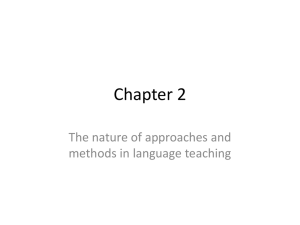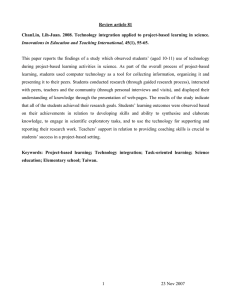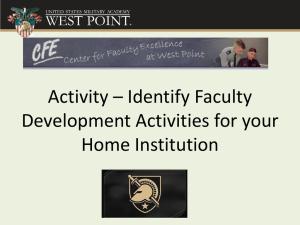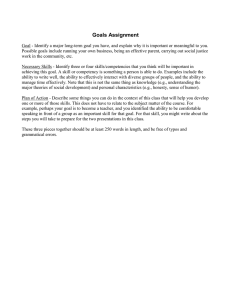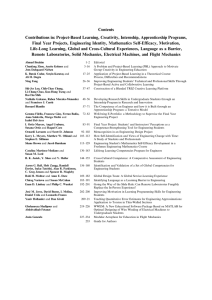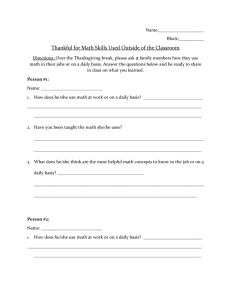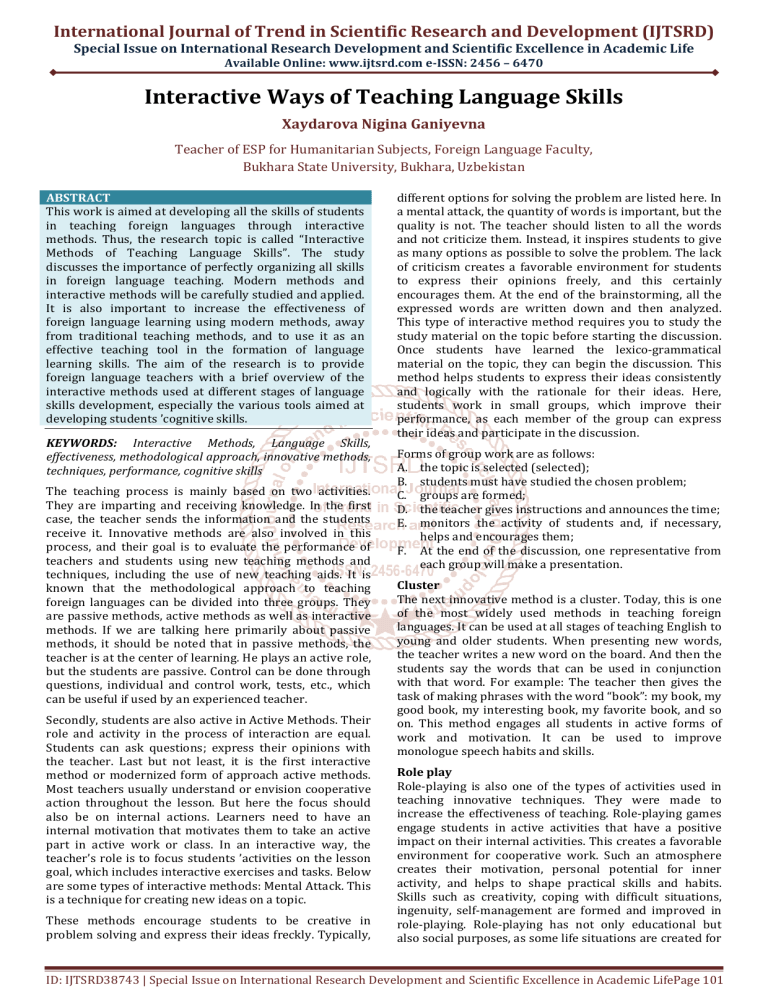
International Journal of Trend in Scientific Research and Development (IJTSRD) Special Issue on International Research Development and Scientific Excellence in Academic Life Available Online: www.ijtsrd.com e-ISSN: 2456 – 6470 Interactive Ways of Teaching Language Skills Xaydarova Nigina Ganiyevna Teacher of ESP for Humanitarian Subjects, Foreign Language Faculty, Bukhara State University, Bukhara, Uzbekistan ABSTRACT This work is aimed at developing all the skills of students in teaching foreign languages through interactive methods. Thus, the research topic is called “Interactive Methods of Teaching Language Skills”. The study discusses the importance of perfectly organizing all skills in foreign language teaching. Modern methods and interactive methods will be carefully studied and applied. It is also important to increase the effectiveness of foreign language learning using modern methods, away from traditional teaching methods, and to use it as an effective teaching tool in the formation of language learning skills. The aim of the research is to provide foreign language teachers with a brief overview of the interactive methods used at different stages of language skills development, especially the various tools aimed at developing students ’cognitive skills. KEYWORDS: Interactive Methods, Language Skills, effectiveness, methodological approach, innovative methods, techniques, performance, cognitive skills The teaching process is mainly based on two activities. They are imparting and receiving knowledge. In the first case, the teacher sends the information and the students receive it. Innovative methods are also involved in this process, and their goal is to evaluate the performance of teachers and students using new teaching methods and techniques, including the use of new teaching aids. It is known that the methodological approach to teaching foreign languages can be divided into three groups. They are passive methods, active methods as well as interactive methods. If we are talking here primarily about passive methods, it should be noted that in passive methods, the teacher is at the center of learning. He plays an active role, but the students are passive. Control can be done through questions, individual and control work, tests, etc., which can be useful if used by an experienced teacher. Secondly, students are also active in Active Methods. Their role and activity in the process of interaction are equal. Students can ask questions; express their opinions with the teacher. Last but not least, it is the first interactive method or modernized form of approach active methods. Most teachers usually understand or envision cooperative action throughout the lesson. But here the focus should also be on internal actions. Learners need to have an internal motivation that motivates them to take an active part in active work or class. In an interactive way, the teacher’s role is to focus students ’activities on the lesson goal, which includes interactive exercises and tasks. Below are some types of interactive methods: Mental Attack. This is a technique for creating new ideas on a topic. These methods encourage students to be creative in problem solving and express their ideas freckly. Typically, different options for solving the problem are listed here. In a mental attack, the quantity of words is important, but the quality is not. The teacher should listen to all the words and not criticize them. Instead, it inspires students to give as many options as possible to solve the problem. The lack of criticism creates a favorable environment for students to express their opinions freely, and this certainly encourages them. At the end of the brainstorming, all the expressed words are written down and then analyzed. This type of interactive method requires you to study the study material on the topic before starting the discussion. Once students have learned the lexico-grammatical material on the topic, they can begin the discussion. This method helps students to express their ideas consistently and logically with the rationale for their ideas. Here, students work in small groups, which improve their performance, as each member of the group can express their ideas and participate in the discussion. Forms of group work are as follows: A. the topic is selected (selected); B. students must have studied the chosen problem; C. groups are formed; D. the teacher gives instructions and announces the time; E. monitors the activity of students and, if necessary, helps and encourages them; F. At the end of the discussion, one representative from each group will make a presentation. Cluster The next innovative method is a cluster. Today, this is one of the most widely used methods in teaching foreign languages. It can be used at all stages of teaching English to young and older students. When presenting new words, the teacher writes a new word on the board. And then the students say the words that can be used in conjunction with that word. For example: The teacher then gives the task of making phrases with the word “book”: my book, my good book, my interesting book, my favorite book, and so on. This method engages all students in active forms of work and motivation. It can be used to improve monologue speech habits and skills. Role play Role-playing is also one of the types of activities used in teaching innovative techniques. They were made to increase the effectiveness of teaching. Role-playing games engage students in active activities that have a positive impact on their internal activities. This creates a favorable environment for cooperative work. Such an atmosphere creates their motivation, personal potential for inner activity, and helps to shape practical skills and habits. Skills such as creativity, coping with difficult situations, ingenuity, self-management are formed and improved in role-playing. Role-playing has not only educational but also social purposes, as some life situations are created for ID: IJTSRD38743 | Special Issue on International Research Development and Scientific Excellence in Academic LifePage 101 International Journal of Trend in Scientific Research and Development (IJTSRD) @ www.ijtsrd.com eISSN: 2456-6470 teaching here. The teacher should follow these guidelines when using the role-playing method in foreign language teaching: Creating a friendly atmosphere among the students participating in the play; Students should feel free and this will help them to perform their roles perfectly; creation of favorable conditions and use of positive aspects in the learning process; Taking into account the personal characteristics of students. Multimedia learning This is another innovative method. It is a combination of different media as text, audio and video materials, through which the teacher provides information to the students. In the process of problem-based learning as a teacher of information technology and an innovative teaching strategy, the teacher encourages students to active knowledge through real-life problems. Advantages of using multimedia education: has a positive effect on the formation of speech habits and skills. An effective conclusion revises the important elements of the lesson and links them to the goal. Reviewing and concluding ideas reinforces students ’knowledge and improves retention of what has been learned. New ideas should not be included in the conclusion, as they may confuse readers at this time. Traditional lesson planning finds more topics that students find useful. This means that students need to learn the grammar and vocabulary that teachers need to know, a lesson around activities that all students feel comfortable with and can relate to. It is important to make plans, skills and competencies. Thus, planning and design is not about what it teaches, but why it is taught, this approach uses individual skills and competencies to teach students materials that should meet their goals and objectives, separates, room, or perhaps more advanced tasks such as analyzing the film or discussing their views on country politics. The language taught in this approach revolves around the task itself, not the other way around. For this method to work, teachers need to understand their students ’needs and expectations in order to design lessons that will help their students succeed. Grammar, vocabulary, and language skills are just tools that allow students to achieve end results. Project-based approach Like the task-based approach, the project-based approach is designed to meet the real needs of students by adapting the language to the skills and competencies they really need, both personally and professionally. This approach begins with setting an important goal for the individual or group of students. For example, if you are teaching a business English lesson, you need to consider why students in the classroom should start the lesson and plan accordingly. They had to prepare monthly accurate reports in English for several departments in their offices. Thus, we divided a single sample report into parts and analyzed each segment. Each student prepared the units as if they were real. In addition to filling in all the vocabulary and grammar needed to complete each section of the lesson, I discussed the challenges my students faced. Their final draft was a completed report that they could submit to the employer for approval, and the criteria for creating our report were based on their company manual. It was a lot of work, but we enjoyed it. This project can range from an oral presentation to a wide range of products such as classroom games. In any case, the project should consist of individual tasks that lead to goals in student assessment. Lexical Syllabus While the previous two approaches focused on the skills and competencies that students need to develop, this approach focuses on what language students should actually create. In particular, real words that students need to understand in order to complete specific tasks. This approach is based on the language that students need to have for their needs. Professional students need very specific dictionaries for their fields. For example, “benefit” is an important term for business students, just as “scalpel” is the same for medical students. In addition, any other language taught outside of this target language should be effective and aimed at ensuring students ’communication in their field. Topics such as movies and hobbies, workplaces can take second place in issues such as booking a hotel or describing a work experience. However, there are common skills in all areas, such as saying your name or providing your personal information. Because this approach focuses on content, assignments and homework should be student-centered. So, the assessment should be based on what the students actually achieved. Examples of these assessments include taking the time to write an application for a job or an interview. This approach requires teachers to understand what students really need, focus on it, and then broaden students ’worldviews as their communication skills develop. The good news is that there is very little research on this topic. Activities can range from customizing images and descriptions to working with dialogues. Describing their favorite seasons or even guessing what they can do in summer or winter can be a progressive twist. Using Smartphones in the Classroom Since almost everyone has an Internet connection or a data plan, banning smartphones can become a missed opportunity to further improve the learning experience. Smartphones can provide important tools such as dictionary, translator, and grammar apps. Just like computers, students need to understand that phones are used as a learning tool, not for play or personal use. A good example of how smartphones improve learning in the classroom is a hunter-gatherer exercise. Here, students have to go through websites to find the information they need to fill out a worksheet. Students can also use their devices to access free, online exercises that reinforce the language and / or skills seen in the lesson. The main problem here is to be creative when using smartphones. Students can record themselves in practice, which helps them get feedback on specific tasks and activities. This allows you to create surveys that students can easily answer using their phones. It can be used as an evaluation tool or as part of an activity portfolio. For example, students could even develop questionnaire questions, complete them, analyze the results, and then create a presentation of those results. Personally, I think one of the other ways to fit smartphones and tablets is without paper. ID: IJTSRD38743 | Special Issue on International Research Development and Scientific Excellence in Academic LifePage 102 International Journal of Trend in Scientific Research and Development (IJTSRD) @ www.ijtsrd.com eISSN: 2456-6470 Bringing it All Together While traditional approaches provide the basis for effective language teaching, it is important to understand that these methods do not always meet the needs of students. In fact, the communicative approach is still widely promoted as the latest and greatest approach, which already needs to change on its own. Next time you are preparing for a new group of students or want to change the way you teach current students, consider the following: A task-based approach focuses on the skills and competencies that students actually need. The project-based approach is based on a task-based approach using specialized interventions. The lexical program provides students with the content they need right outside the door. Combine this with the effective use of technology in the classroom and you will have a winning formula that no teacher will ignore. “Classroom,” the word reminds us, in which a teacher reads a lecture in front of a class of 30-40 students with a specific level of gravity in their voice. This is a common teaching method when we were in school twenty years ago. However, things have changed over the years and while this is one of the most effective ways to teach English to young students, it is no longer considered the same. This is probably due to various reasons: The current generation gets acquainted with the world through social networks Their knowledge base is filled with information available on the Internet Today, students are more impatient and teaching methods need to be adapted to their dynamic thinking process in order to attract their attention. Language teaching, like other topics, has undergone many changes. He switched from the usual methods to roleplaying games, interactive games, short visuals, and so on, for example, tutor lectures with a board only to support repetition and grammar tables and spelling. In general, everything you teach should be appropriate to the student environment, as students are the focal point of the teaching and learning process. Planning and designing English teaching lessons According to V.B Yeats, “Education is not about filling a bucket, but about lighting a fire,” 21st century educators have created unique ways to make learning more fun and easier to understand. There are difficulties in language teaching. Often, this is a foreign language that the student cannot choose from around them, and you need to teach it patiently and systematically so that students can read, write, and speak the language with confidence and without difficulty. English is a world language, and English teachers have changed their teaching methods over the years to suit the current scenario. In this article, I will discuss some of the most popular and effective ways to teach English that meet the needs of modern students. This method of teaching English is a classical method that has been used since the 16th century. This approach is often fabricated to teach Latin that people do not learn and do not speak. The method of teaching English is aimed at translating Latin texts into the mother tongue in accordance with the grammatical rules and phrases of the Latin language and then mastering it. Rote learning is the most widely used method in vocabulary learning. Later, this method was used to study other languages that were considered second languages. So this also applies to English. This approach is devoid of the fact that it is not a very good way to teach proper communication in English. Although this modern method has been widely criticized in modern times, it is still used by many institutions, especially by those who want to study English scientifically. Natural Method – This method, also known as the direct method of teaching English, seems to be a response to the Grammatical Translation Technique. In this process, the teacher, who aims to teach English as a second language, asks the student to meditate in English so that they can communicate in English. The technique aims to establish a connection between thought and expression. He asked the teacher to strictly forbid the student from using his mother tongue. The learner must express himself in correct English, using the right accent and grammatical skills. This method of teaching English is used in modern times and is useful in teaching communication in English. As the student thinks and speaks in English in real-life situations, they learn the language clearly and there is no reading or translation here. This may take some time, but what is learned will have a long-lasting effect on our memory. Audio Lingual – This method of teaching English was originally called the “army method” because it emerged during World War II when soldiers needed to learn the language of their opponents. It’s kind of a straightforward style in some ways. This approach is based on thinking in language and expressing ideas in the same way. And in the process, learning happens. The teaching process is based on Skinner’s theory of behaviorism and his experimental experience in operational conditioning. Accordingly, positive reinforcement helps in learning new things. In this approach, the student should learn the structure and everyday use of language rather than emphasizing word comprehension. Patterns of simple discussions are taught and students repeat it, followed by a test. This process is done until the student answers correctly. In summary, the process of the audio-linguistic method is characterized by conventional drilling, which is used in everyday communication and ignores grammatical rules, the words taught are contextual, and audiovisual aids are used in the technique. It focuses on pronunciation, and finally, any correct answer is immediately positively amplified. The method of teaching English is still in use today and is suitable for learning to communicate properly in English or any other second language. Nevertheless, extensive re-learning and memorization led to a lack of regular learning of English, which created a barrier to different communication. Humanistic Approach – During the 1970s, the course of teaching and learning changed radically, in which the innate potential and skills ID: IJTSRD38743 | Special Issue on International Research Development and Scientific Excellence in Academic LifePage 103 International Journal of Trend in Scientific Research and Development (IJTSRD) @ www.ijtsrd.com eISSN: 2456-6470 acquired by the student became the focal point of the educational process. Based on this idea, several teaching methods have been developed and combined under the name of humanistic approach. Here are some ways to teach English based on a humanistic approach: Suggestopedia– This method of teaching English is based on the fact that the mind has great potential and memorizes information on suggestions. This method uses certain principles of memory to teach English as a second language. Students are introduced to new information in their original language (English in our case) and it is read aloud with classical music in the background. This session is known as concert reading. The idea of propidopedia is to provide the mind with a conducive environment for learning and storing this information. This method is useful if the student is shy or scared. Proponents of this approach include Georgi Lozanov, who has become an accelerated learning movement. Silent WayThis method of teaching English, also known as the natural approach, is based on the idea that human beings learn how to speak their mother tongue. Caleb Gattegno invented this method of teaching the language. According to him, the teacher should be as silent as possible, but students should be encouraged to speak the language. The silent method uses elements such as colored tables and colored kitchen sticks and more. Some principles based on this method are: Learning occurs when a student learns to discover new things about a foreign language and has a creative approach instead of repeating what has been taught. Education is stimulated by the physical things around it. It is based on solving problems This method of teaching English is very suitable for beginners or English learners. Total Physical ResponseThis method involves playing the language rather than speaking. This can be by imitating or just responding to audiovisual signals. Games like “Simon says ...” or charades are classic examples of this teaching style. This method is an interesting way to learn a language and is therefore very useful. Comprehensive Content and Language Learning (CLIL) This method applies to schools where most of the important subjects are taught in English. This is common in modern classrooms. The focus is on content and the lessons are structured according to the student’s needs and desires. CLIL is effective in teaching students to use English as a means of cultural expression in life. Teaching communicative languages This broad term is an accepted standard of English language teaching in modern times. It ignores grammatical fluency. Instead, he emphasizes conveying the meaning of the message; in other words, it focuses on how well a person (not a native speaker) can speak English. Different features of this method: The interaction in English results understanding of the language. is a correct Students will be taught English comprehension strategies. Student experiences focus on organizing the content of lessons. Real text in English is used for teaching Principle eclecticism: This refers to the diversity of teaching depending on the ability of the learner. Different methods are combined according to the student's request. Each unique method has its strengths and weaknesses. It may therefore not be appropriate for a particular learner, so the teacher uses a combination of techniques to make the language comprehensible in this approach. Interactive technologies can be characterized by the exchange and exchange of views on and against a controversial issue. Any discussion-based lesson will be effective if the participants have a basic knowledge of the subject and the teacher has planned the main steps and key points in advance. In the planning phase, the teacher selects and shapes the problem, planning ways to stimulate and control the activities of the participants. He should prepare the necessary equipment to record the students ’ideas. When the discussion begins, the teacher acts as a facilitator. It is very important to be able to take different views on a particular problem, have your own opinion, draw conclusions and evaluate achievements. You can use a variety of ways to introduce the topic to the audience: describe the problematic situation, ask problematic questions, show a video, play a role in the situation, provide a few ideas on the issue. At the end of the discussion, it should include a variety of views that will change the decision. One of the most effective types of discussions is the “roundtable” style. 1015 students sit around a table and discuss a specific problem. The host has a leadership role; it could be a student or a teacher. The purpose of the activity is not to find a final solution, but to discuss the problem, gather as much information as possible, understand the importance of solving the problem, find ways to achieve the goals. When students sit in a roundtable discussion, they make eye contact with all members of the discussion, everyone feels the same and important. It stimulates conversation, increases the number of words, and encourages the use of nonverbal communication tools (imitation, gestures). The “round table” technique can be combined with role-playing or business games. A project method is a set of research, data processing, and other activities conducted by students independently or in small groups to solve important problems in a practical or theoretical way. Project-based teaching involves a different philosophy on the principle of building the learning process through targeted activities in accordance with the personal interests and goals of students. As can be seen, the project approach opens up opportunities for students to express themselves, define their skills, and define future careers. In other words, the student has the opportunity to test himself in different areas, to reveal something sincere and interesting, and to focus on his own desires, strengths, and abilities. And, most importantly, all his activities are aimed at shaping his thinking based on his personal experience. He shares responsibility for his own development for the ID: IJTSRD38743 | Special Issue on International Research Development and Scientific Excellence in Academic LifePage 104 International Journal of Trend in Scientific Research and Development (IJTSRD) @ www.ijtsrd.com eISSN: 2456-6470 level of readiness for future self-employment. The project method always finds a solution to some problem. The solution to the problem, on the one hand, involves the integration of different methods and means of education, and the International Letter of the Social Sciences and Humanities. 71 55 on the other hand - the need to combine knowledge and skills in different fields of science, engineering, technology and creativity. The main objectives of project-based learning are: to create conditions for students to independently and independently acquire the missing knowledge from various sources; to study the use of the acquired knowledge in solving practical and cognitive problems; acquire communication skills by working in different groups; develop their research skills (problem identification, data collection, observations, experiments, analysis, hypotheses, generalization); development of systematic thinking. Foreign methodological literature includes the following stages of the project: - identification of the project topic, problem, goals; discussion of the project structure, planning; presentation of language material; data collection; group analysis and discussion of data with the teacher; preparation of the presentation; demonstration of project results; project evaluation. The final stage includes not only mastering linguistic materials and monitoring the development of speech and communicative competence, but also the content of the project, the topic, the final result, the overall assessment of the project with the participation of individual students, organization of project work, etc. Project-based teaching mainly involves the use of a wide range of research techniques, taking into account a variety of factors and conditions that are important to the student on the one hand, and important for the complex development of the problem on the other, resolve and implement results. Project-based teaching has been widely used in many countries around the world, as it allows students to seamlessly integrate their knowledge around a solution to a problem in different areas, while at the same time allowing that knowledge to be put into practice, creating new ideas. As mentioned earlier, there are some issues at the center of the project. To solve it, students need not only knowledge of the language, but also a sufficient amount of subject knowledge necessary to deal with the problem. In addition, students must have certain intellectual, creative, communicative skills. They are able to work with information, the ability to work with text (highlight the main idea, search for the necessary information from a text in a foreign language), analyze data, generalize, draw conclusions, etc., work with different things includes the ability. The formation of these skills involves teaching different types of speech activities. References: [1] Mamedova M. A. "Methodical features of teaching homonyms of English language using computer technology", International Journal of psychosocial Rehabilitation, Vol. 8, Issue 1, January 2020. [2] Yusupova Sh. (2020). Improvement of students’ technical thinking development technologies at english classes. International Journal of Advanced Science and Technology, 29(05). 1472 - 1478 p. [3] Yusupova Sh. (2020). Factors Of Students’ Technical Thinking Development In English Lessons At Technical Universities. International Journal for Social Studies, 6(1).42-47 p. [4] Nosirova N. S. The issue of artistic psychology to literary studies //Theoretical & Applied Science. – 2020. – №. 2. – С. 110-112. [5] Khaydarova N. G., Ramazonov M. PSYCHOLOGICAL APPROACH IN TEACHING METHODS //Достижениянаукииобразования. – 2017. – №. 4. – С. 101-102. [6] Khaydarova N. G. THE PECULIARITIES OF MAKING PERFECT LESSON PLAN //Достижениянаукииобразования. – 2018. – №. 5. – С. 45-46. [7] Khaydarova N. G., Muhammedov M. THE IMPORTANCE OF SPEAKING SKILLS FOR EFL LEARNERS //Достижениянаукииобразования. – 2019. – №. 1. – С. 60-61. ID: IJTSRD38743 | Special Issue on International Research Development and Scientific Excellence in Academic LifePage 105


